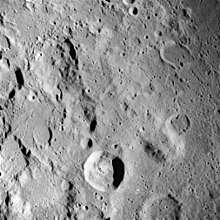Zöllner (crater)
Zöllner is a lunar impact crater located to the west of Sinus Asperitatis. It was named after German astrophysicist and astronomer Johann Karl Friedrich Zöllner.[1] To the north is the smaller crater Alfraganus and to the northwest lies the oval-shaped Taylor. Southeast of Zöllner is the smaller crater Kant.
 Lunar Orbiter 4 image | |
| Coordinates | 8.0°S 18.9°E |
|---|---|
| Diameter | 47 × 36 km |
| Depth | 0.7 km |
| Colongitude | 341° at sunrise |
| Eponym | Johann K. F. Zöllner |
The rim of Zöllner forms an irregular oval, with the formation being longer in a north–south direction. The wall is low and worn, with a distorted, crater-like depression attached to the southeast of the rim. The narrow floor still retains a central peak.
The Apollo 16 landing site is located about 80 kilometers west-southwest of the crater rim.
Satellite craters
By convention these features are identified on lunar maps by placing the letter on the side of the crater midpoint that is closest to Zöllner.
| Zöllner | Latitude | Longitude | Diameter |
|---|---|---|---|
| A | 7.1° S | 21.5° E | 7 km |
| D | 8.3° S | 17.7° E | 24 km |
| E | 8.9° S | 18.3° E | 6 km |
| F | 7.5° S | 21.9° E | 25 km |
| G | 7.3° S | 20.8° E | 10 km |
| H | 7.1° S | 19.2° E | 8 km |
| J | 6.2° S | 20.7° E | 11 km |
| K | 6.5° S | 20.8° E | 7 km |
References
- "Zöllner (crater)". Gazetteer of Planetary Nomenclature. USGS Astrogeology Research Program., accessed 20 February 2019
- Andersson, L. E.; Whitaker, E. A. (1982). NASA Catalogue of Lunar Nomenclature. NASA RP-1097.CS1 maint: ref=harv (link)
- Bussey, B.; Spudis, P. (2004). The Clementine Atlas of the Moon. New York: Cambridge University Press. ISBN 978-0-521-81528-4.CS1 maint: ref=harv (link)
- Cocks, Elijah E.; Cocks, Josiah C. (1995). Who's Who on the Moon: A Biographical Dictionary of Lunar Nomenclature. Tudor Publishers. ISBN 978-0-936389-27-1.CS1 maint: ref=harv (link)
- McDowell, Jonathan (July 15, 2007). "Lunar Nomenclature". Jonathan's Space Report. Retrieved 2007-10-24.CS1 maint: ref=harv (link)
- Menzel, D. H.; Minnaert, M.; Levin, B.; Dollfus, A.; Bell, B. (1971). "Report on Lunar Nomenclature by the Working Group of Commission 17 of the IAU". Space Science Reviews. 12 (2): 136–186. Bibcode:1971SSRv...12..136M. doi:10.1007/BF00171763.CS1 maint: ref=harv (link)
- Moore, Patrick (2001). On the Moon. Sterling Publishing Co. ISBN 978-0-304-35469-6.CS1 maint: ref=harv (link)
- Price, Fred W. (1988). The Moon Observer's Handbook. Cambridge University Press. ISBN 978-0-521-33500-3.CS1 maint: ref=harv (link)
- Rükl, Antonín (1990). Atlas of the Moon. Kalmbach Books. ISBN 978-0-913135-17-4.CS1 maint: ref=harv (link)
- Webb, Rev. T. W. (1962). Celestial Objects for Common Telescopes (6th revised ed.). Dover. ISBN 978-0-486-20917-3.CS1 maint: ref=harv (link)
- Whitaker, Ewen A. (1999). Mapping and Naming the Moon. Cambridge University Press. ISBN 978-0-521-62248-6.CS1 maint: ref=harv (link)
- Wlasuk, Peter T. (2000). Observing the Moon. Springer. ISBN 978-1-85233-193-1.CS1 maint: ref=harv (link)
External links
| Wikimedia Commons has media related to Zöllner (crater). |
- Zöllner at The Moon Wiki
- Wood, Chuck (December 19, 2006). "A Gray Day". Lunar Photo of the Day. Archived from the original on October 20, 2017.
